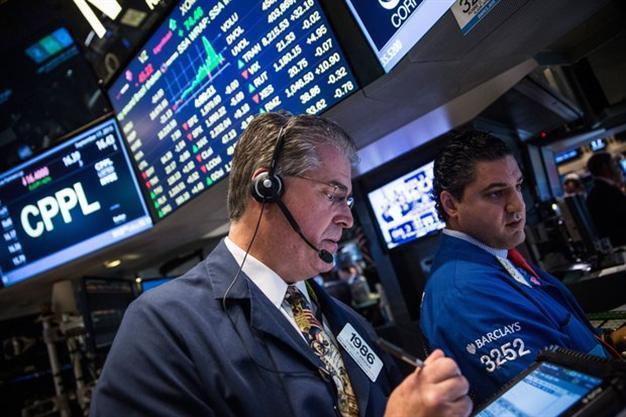Developed, emerging markets diverge as Fed keeps rates steady
LONDON - Reuters

AFP photo
Developed market stocks fell on Sept. 18 and bonds rose, pushing yields sharply lower, after the U.S. Federal Reserve cited weakening global growth and the recent upsurge in financial market volatility as its reasons for not raising interest rates.Stocks and currencies in emerging markets, however, which are more vulnerable to higher U.S. interest rates, welcomed the Fed’s decision on Sept. 17 to postpone “lift off” for at least another month, and rose across the board.
The FTSEuroFirst index of leading 300 shares slid 2 percent to 1,396 points, its biggest fall in two weeks.
Germany’s DAX fell 2.6 percent to 9,961 points and France’s CAC 40 was down 2.3 percent at 4,546 points.
Britain’s FTSE 100 index also followed Wall Street’s overnight lead, and was down 1 percent at 6,121 points.
U.S. futures predicted a fall of almost 1 percent at the open later on Sept. 18.
European government bond yields tumbled, tracking the 2-year U.S. Treasury yield’s biggest fall since Treasuries were first included in the Fed’s quantitative easing bond-buying stimulus program in March 2009.
The 10-year German Bund yield was down 12 basis points, on course for the biggest one-day fall since early July and the second biggest this year.
A growing number of economists, including those at Morgan Stanley and Barclays, are now wondering whether the Fed will raise rates at all this year, given its concerns over growth and market volatility, as well as the strength of the dollar.
“The Fed’s rather downbeat outlook came as an unwelcome surprise, and it’s likely to take a while for investors to figure out whether the Fed is seeing something that the rest of us aren’t,” said Michael Hewson, chief strategist at CMC Markets.
Bank of England chief economist Andy Haldane said on Sept. 18 the BoE may have to cut interest rates if inflation remains low and global risks materialize. European Central Bank policymaker Benoit Coeure said global growth prospects have darkened, particularly in emerging markets.
Fed Chair Janet Yellen said the global outlook has appeared to become less certain, adding that recent falls in U.S. stock prices and a rise in the value of the dollar were already tightening U.S. financial market conditions.
The Fed’s fresh economic projections showed 13 of 17 policymakers still foresee at least one rate hike in 2015, down only slightly from 15 at the last forecast made in June. But it also trimmed its forecasts for 2016 and 2017 economic growth.
Re-emerging markets
Earlier in Asia, MSCI’s broadest index of Asia-Pacific shares outside Japan rose 1.1 percent to a four-week high. It was the index’s third consecutive daily increase, something not seen since early July.
Yellen explicitly noted the central bank was focusing on the slowdown in China and emerging markets, saying one key issue is whether there might be a risk of a more abrupt slowdown in China.
“Now it’s a waiting game again, and every upcoming meeting is on the table so long as data and conditions can justify a move. However, there is no guarantee that the conditions will be satisfactory ahead of the end of 2015,” said Lee Ferridge at State Street.
A sudden devaluation of the yuan by the People’s Bank of China’s last month surprised global markets and stoked worries that its economy may be in worse shape than previously thought.
A Barclays survey of more than 700 global investors published this week showed that most believed Chinese growth figures are overstated, with more than half of those saying by as much as two full percentage points.
Emerging market equities rose to one-month highs on Sept. 18, with MSCI’s broadest emerging market index up 0.6 percent and on track for the biggest weekly rise since early April, with 3.7 percent gains.
However, Japan’s Nikkei average, in line with other developed equity markets, ended three days of gains to close 2 percent lower.
In currencies, the dollar was still on the defensive after falling more than 1 percent just after the Fed’s decision. The dollar index against a basket of major currencies was down a quarter of one percent to a three-week low of 94.301 on Sept. 18.
The euro was steady at $1.1435, having hit a three-week high of $1.1459 earlier on Friday. The dollar fell 0.7 percent against the yen to 119.20 yen.
U.S. debt yields remained under downward pressure, with the two-year note’s yield slipping a further 4 basis points to 0.66 percent, only a day after it hit a 4 1/2-year high of 0.819 percent.
In commodities, U.S. crude futures were down 1.1 percent at $46.37 per barrel, but still up more than 4 percent on the week. Brent was a touch lower at $48.95 a barrel.
Gold took heart from the dollar’s travails and hit a two-week high of $1,139 per ounce. It last stood at $1,136.
















